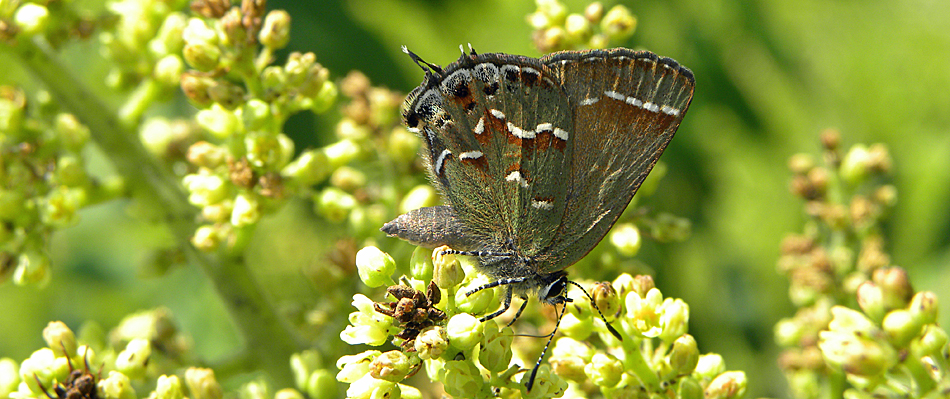If you're a plant needing birds to disperse your seeds, it's a good strategy to ripen your fruit when there are the maximum number of birds around. In North America, the fall migration is a perfect opportunity: thousands of hungry birds traveling long distances, eager to refuel by snacking on succulent fruit. Competition is stiff, though. Lots of plants ripen fruit in the fall, so how do you stand out from the crowd?
Some plants offer high quality fruits: juicy, sweet, and irresistible. Most of these get gobbled up fast, though there are drawbacks. Fruit not eaten immediately can go bad, and are then unlikely to be dispersed.
Most of the eastern US sumacs (ex. Rhus copallinum, R. glabra, R. typhina) use a different strategy. They, too, fruit in the fall, but make lower quality fruit: rather dry and without a lot of flesh to them, not very sweet, but with some fat content for energy (11-26% of their weight, according to Stiles (1980)). Initially, birds mostly ignore ...περισσότερα ↓
If you're a plant needing birds to disperse your seeds, it's a good strategy to ripen your fruit when there are the maximum number of birds around. In North America, the fall migration is a perfect opportunity: thousands of hungry birds traveling long distances, eager to refuel by snacking on succulent fruit. Competition is stiff, though. Lots of plants ripen fruit in the fall, so how do you stand out from the crowd?
Some plants offer high quality fruits: juicy, sweet, and irresistible. Most of these get gobbled up fast, though there are drawbacks. Fruit not eaten immediately can go bad, and are then unlikely to be dispersed.
Most of the eastern US sumacs (ex. Rhus copallinum, R. glabra, R. typhina) use a different strategy. They, too, fruit in the fall, but make lower quality fruit: rather dry and without a lot of flesh to them, not very sweet, but with some fat content for energy (11-26% of their weight, according to Stiles (1980)). Initially, birds mostly ignore these, but the fruit don't go bad, and continue to hang on the plants through the long, cold, hungry months of winter. In fact, many of these sumacs will still have much of the last year's fruit on them well into the spring and summer.
Overwintering birds can't be as picky as fall migrants with a wealth of fruit to choose from, so sumac fruit are a hit over winter. Over 300 species of songbirds are known to eat sumac fruit, as well as turkey, quail, pheasant, and grouse (USDA, 2002).
This drawn-out fruiting strategy makes sumacs doubly desirable as garden plants: the clusters of red fruit provide flashes of color in an otherwise dull winter landscape and provide a critical food source for overwintering birds. Win-win.
Winter Robins Eating Sumac
Winter Chicadee Eating Sumac
Winter Blue Jay With Sumac
References:
Stiles, EW. 1980. Patterns of fruit presentation and seed dispersal in bird-disseminated woody plants in the eastern deciduous forest. The American Naturalist, 116(5): 670-88.
(USDA) United States Department of Agriculture. 2002. Plant Fact Sheet: Winged Sumac (Rhus copallinum). 2 pages.
λιγότερα ↑








